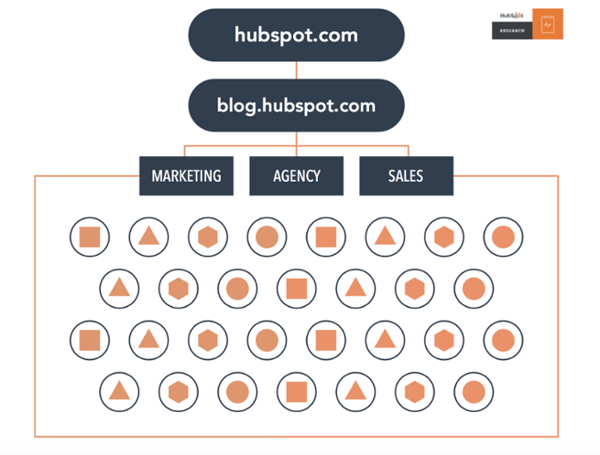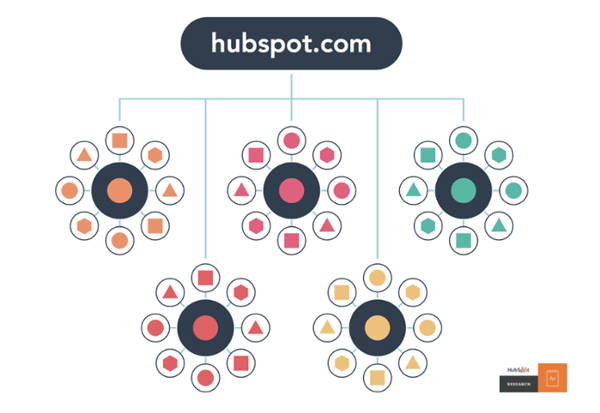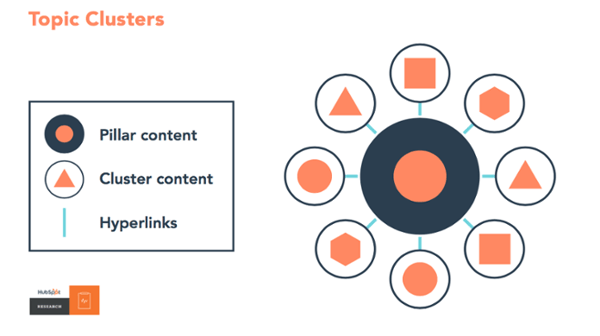Here on the HubSpot blog, we've been writing content for a long time -- more than 10 years.
And for much of that time, our strategy for determining our editorial calendar has stayed the same: We've identified keywords we want to rank for in search, written a blog post about it, and moved onto the next one.
And for a while, that strategy has worked for us, and we were able to start ranking for competitive keywords in search engine results pages (SERPs). But eventually, after years and years of creating content in this same vein, our blog became cluttered, it was tougher for searchers to find the exact answer to questions they asked -- and our URLs started to compete with one another.
After all, how many different ways are there to write about Instagram? In our case, the answer is ... a whole lot of ways.
Enter topic clusters, a new way to organize your website infrastructure that helps you rank higher in SERPs and provide a more organized user experience to your visitors. In this blog post, we'll review topic clusters and how you can use them to organize your editorial calendar.
What are Topic Clusters?
Topic clusters are a way to organize a site infrastructure so content about a particular topic is grouped together -- and anchored by a pillar page (more on that next).
Remember the old blog structure I described? It involved a ton of blog posts -- but resulted in a disorganized experience for someone trying to search for information on your site:

Topic clusters focus on -- you guessed it -- topics over keywords. Instead of simply choosing particular long-tail keywords to write and optimize a blog post about to try to rank in search, this model more intentionally organizes a site architecture into topic groups.
In this new structure, each topic has a pillar page that broadly covers the main points about a given topic, and that pillar page links out to blog posts that target those long-tail keywords that are related to the pillar page's topic. Here's what it looks like in action:

What Is a Pillar Page?
A pillar page is the basis on which a topic cluster is built. It covers all aspects of a particular topic on a single page, with room for more in-depth coverage in more detailed cluster blog posts that hyperlink back to the pillar page.
If you check out the structure of the more organized site above, these are the basic components:

The pillar page is at the center of the topic cluster, and it shares links with supporting blog posts that deep-dive into specific aspects of the broader topic.
For example, on the HubSpot domain, we have an Instagram marketing pillar page. It's a broad topic, so the pillar page is lengthy and provides an overview of every aspect of the topic. Here are some of the details it covers:

Then, further down on the pillar page, the content contains hyperlinks to blog posts that dive deeper into particular aspects -- like Instagram caption tips and details about the algorithm.

You can see one of those blog posts here -- which links back to the pillar page above.

Structuring your blog content this way helps more of your blog posts and web pages rank in search, and it provides a reader experience that makes sense -- they can start at the pillar page and dive deeper into particular aspects, or they can start with a blog post and go back to the pillar page to learn the basics.
So, how do you get started with turning your editorial strategy on its head and optimizing your entire blog for this new structure? That's next.
How to Structure Your Editorial Calendar to Optimize for Search
1) Identify topics.
This might be how you choose blog posts already, or it might be totally new -- but the first step in this process is focusing on topics, and not keywords. At least at first.
Decide on topics by using your buyer persona research skills -- identify your audience and what they're searching for, and determine how broad to make your pillar page. In our case, "social media" was too broad of a topic, but "Instagram marketing" is sufficient to create a pillar page and 20-30 related blog posts.
2) Choose (or create) a pillar page.
Depending on how extensively (or not) you've already covered a particular topic on your blog, you might already have the content you need to create a pillar page -- or, you might need to start from scratch.
HubSpot Senior Content Strategist Leslie Ye, who took up the lion's share of reorganizing the HubSpot Sales Blog into topic clusters, suggests asking the following questions to determine if a blog post can serve as a pillar page:
"Would this page answer every question the reader who searched X keyword had, AND is it broad enough to be an umbrella for 20-30 posts?"
Ye's rule of thumb is: If a blog post is targeting one particular, narrow long-tail keyword, it can't be a pillar page. But, if it explores many aspects of a broad topic more generally, it could serve as your pillar page.
Take your list of topics determined in Step One, audit your content to decide which blog posts can serve as pillar pages, and note content gaps where you need to create new pillar pages (which you can read more about here.)
3) Identify keywords.
Once you've nailed down your topics and your pillar pages, now it's time to start focusing on keywords. Conduct keyword research related to each topic to identify keywords and terms that dive into aspects of your broader topic in greater detail.
These keywords will serve as the main focus of blog posts that will make up your topic cluster -- and link back to the main pillar page.
Remember the example above? Where "Instagram marketing" is the topic that makes up the cluster, "Instagram captions" is a more narrow keyword that we wrote a blog post about within the topic cluster.
4) Start writing.
You know how to do this part -- get to writing.
Organize your editorial calendar by identifying content gaps in your topic clusters, and filling them out as quickly and efficiently as possible. The faster you write and publish blog posts that answer all questions about your topic, the higher these clusters will rank in search.
I might suggest working on a few different clusters at once, so you can keep your recent blog posts varied and interesting for your readers -- instead of publishing several consecutive blog posts within the same topic.
5) Add internal links.
Before pressing publish, make sure you've leveraged internal links to spread the SEO wealth amongst all of your pillar pages and blog posts. Make sure that your pillar page links out to cluster blog posts -- for example, the Instagram marketing pillar page links out to the Instagram captions blog post.
Then, make sure the cluster's more specific blog posts link back to the pillar page -- using the anchor text of the broad topic to help the pillar page rank higher in search. For example, in the Instagram captions blog post, it links back to the Instagram marketing pillar page -- with the words "Instagram marketing" hyperlinked:

If you're confused, don't worry -- this model is new to us, too. Luckily, HubSpot's new Content Strategy tool can do the work for you. Dive into the in-depth guide to using Content Strategy to take your SEO to the next level, or watch this video to learn more about the principles:

from Marketing https://blog.hubspot.com/marketing/editorial-calendar-pillar-cluster
No comments:
Post a Comment